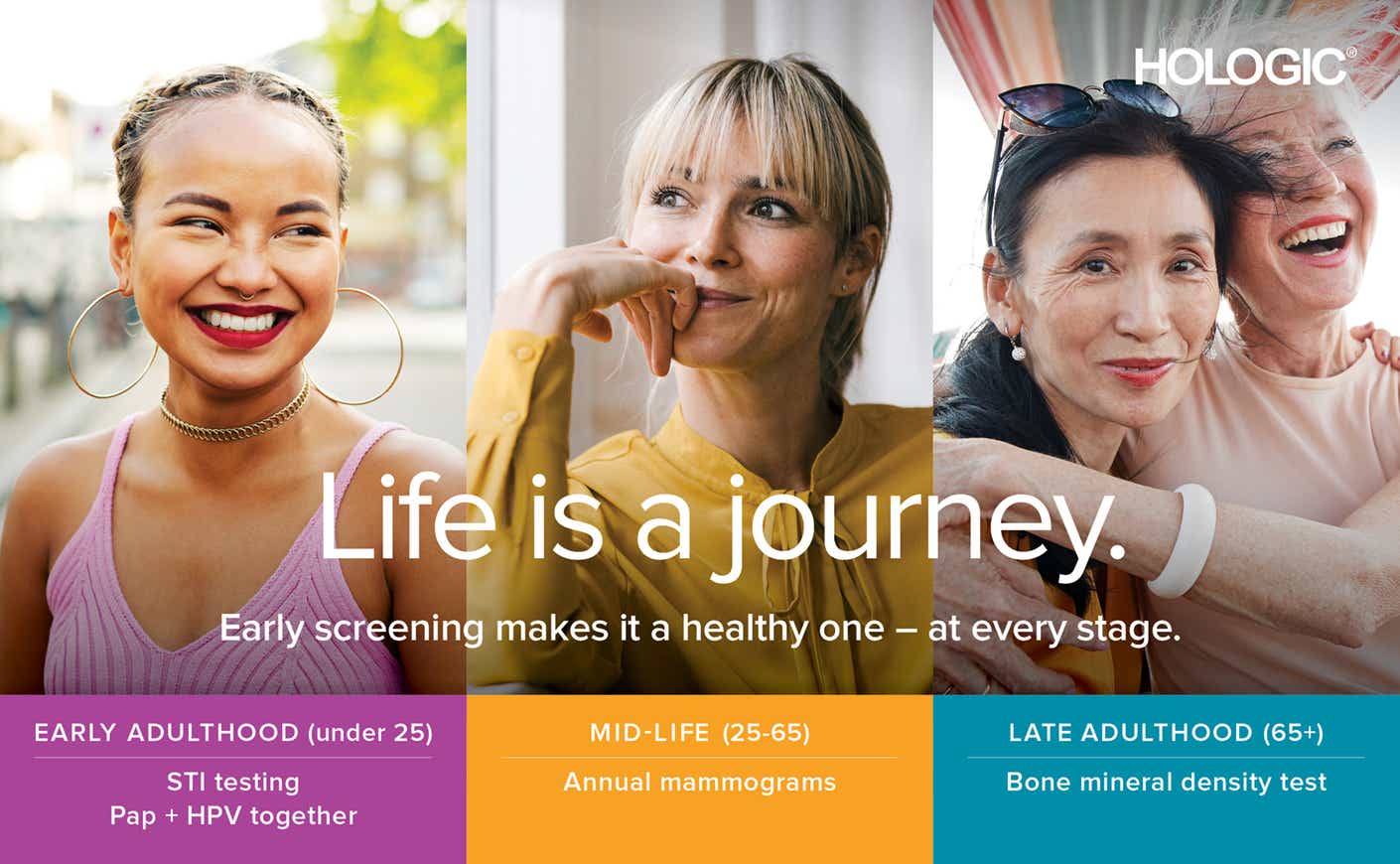The key to a healthy lifestyle is regular wellness screenings — especially since they can provide early detection for life-threatening issues. While different screenings usually happen at different life stages, women around the world still get conflicting info about when to start many of them.
We’re exploring the general guidelines for when women should get regular health screenings — from mammograms to osteoporosis checks — during their annual appointments.

Early Adulthood
As women grow up, many of them start to take more control of their health. That often involves regular well-woman exams, building a relationship with a new doctor, and getting screened for sexually transmitted infections (STI) and cervical cancer.
The Centers for Disease Control and Prevention (CDC) recommend that women under 25 (or those who are 25 and older and in a high-risk group) receive an annual chlamydia and gonorrhea screening.
One ultra-important note? Not all STIs cause symptoms. That’s why testing and treatment are critical to protecting sexual and reproductive health for the future. Luckily, reliable STI screenings can be done through a simple swab sample, such as with the Aptima® portfolio that can detect chlamydia, gonorrhea, mycoplasma genitalium, Herpes 1 and 2, and the most common STI, Trichomonas vaginalis, with just one swab.
Beginning in their twenties, women should also start screenings for cervical cancer. For women ages 21-29, screening with Pap testing is recommended, and for women ages 30-65, Pap + HPV together (co-testing) is recommended.*
When detected early, cervical cancer and pre-cancer are highly treatable. The American Cancer Society estimates that when detected early cervical cancer has a 5-year 92% survival rate (1). Still, though it’s clearly vital to get consistent and thorough screening, nearly 20% of women aged 21-65 in the US in 2018 reported that they weren’t up-to-date with cervical cancer screening. That’s 16 million women who aren’t following up on their gynecologic health the way that doctors recommend. (2)
Mid-Life
To put it simply, breast-health screenings save lives. Worldwide, in 2020, around 2.3 million women were diagnosed with breast cancer, and, sadly, about 685,000 died of the disease (3). But with early detection, diagnosis, and treatment, the World Health Organization (WHO) says survival probabilities can be 90% or higher (4).
The American College of Obstetricians and Gynecologists recommends that women of average risk start with annual breast screenings at age 40 as part of their well-woman exam, and continue them until at least age 75.
Thanks to recent improvements in breast-screening technology — like digital breast tomosynthesis (DBT) that shows breast tissue layer by layer — doctors are seeing more accurate results from these tests. DBT systems, such as the Genius® 3D Mammography™ exam, provide an even more thorough examination of breast tissue, by making fine details more visible, which can provide a clearer picture of calcification and masses.
For some women, 3DTM mammography could mean earlier diagnosis and a greater variety of treatments, since studies have shown that the Genius exam detects 20-65% more invasive breast cancers than 2D screenings (5). The exam has also been shown to reduce callbacks by up to 40% compared to 2D mammography alone (6, 7). This could spare women the emotional, practical, and economic toll of further testing, including biopsies, when ultimately, there might be nothing wrong.
With accessible screenings, quality treatment, and survivor follow-up care improvements, the WHO has seen survival rates worldwide increase from 2 to 4% per year (8).
Find a facility offering 3D™ mammograms at Genius3DNearMe.com.
Late Adulthood
Each year, osteoporosis is attributed to 2 million bone breaks in the United States. (Ouch.) Fortunately, there are ways to detect and treat this condition before that worst-case scenario.
As part of your well-woman exam in late adulthood, your doctor should recommend screening for osteoporosis. The Bone Health & Osteoporosis Foundation recommends that all women over 65 or of postmenopausal age with risk factors talk to their doctors about undergoing a bone density test to diagnose osteoporosis (9). The Horizon® DXA system is the latest in densitometry technology: It provides a complete fracture-risk assessment through a painless, 15-minute test.
Of course, it’s ideal to prevent osteoporosis in the first place. To avoid it, doctors encourage women under 65 to limit their salt, caffeine, alcohol, and smoking, and to do plenty of muscle-building exercises (10,11) (Time to pick up those weights you’ve been storing in the garage.) Once women are 65 and older, they should keep a flashlight at their bedside to avoid nighttime falls, wear shoes with rubber soles, and do plenty of cardio exercises like walking, stair-climbing, playing tennis, or dancing (12, 13).
When it comes to cervical cancer, women over 65 years don’t need to be screened after they’ve gotten prior negative screening results (14).
Wellness screenings save lives, so it’s so incredibly important to ask your doctor when you should be screened for STIs, cervical and breast cancer, and osteoporosis. Depending on your family history and lifestyle, they may recommend screenings sooner than the ages listed here. Regardless, staying on top of your screening schedule will give you peace of mind for now, and all the years to come.
* There are two additional screening methodologies also recommended in this age group. For more information, see the April 2021 ACOG Practice Advisory.
Hologic, Inc. ©2021 All rights reserved. Hologic, Aptima, Genius, 3D, 3D Mammography, Horizon DXA, The Science of Sure and associated logos are trademarks and/or registered trademarks of Hologic, Inc., and/or its subsidiaries in the United States and/or other countries. This information is not intended as a product solicitation or promotion where such activities are prohibited. Because Hologic materials are distributed through websites, eBroadcasts and tradeshows, it is not always possible to control where such materials appear. For specific information on what products are for sale in a particular country, please contact your local Hologic representative. The content in this piece is for information purposes only and is not intended to be medical advice. Please contact your medical professional for specific advice regarding your health and treatment.
1. “Cervical Cancer Survival Rates: Cancer 5 Year Survival Rates.” American Cancer Society, https://www.cancer.org/cancer/cervical-cancer/detection-diagnosis-staging/survival.html
2. “Cancer Screening Test Receipt – United States, 2018.” Centers for Disease Control and Prevention, Centers for Disease Control and Prevention, 14 Jan. 2021, https://www.cdc.gov/mmwr/volumes/70/wr/mm7002a1.htm.
3. https://acsjournals.onlinelibrary.wiley.com/doi/10.3322/caac.21660
4. https://www.who.int/news-room/fact-sheets/detail/breast-cancer
5. Results from Friedewald, SM, et al. “Breast cancer screening using tomosynthesis in combination with digital mammography.” JAMA 311.24 (2014): 2499-2507; a multi-site (13), non-randomized, historical control study of 454,000 screening mammograms investigating the initial impact the introduction of the Hologic Selenia Dimensions on screening outcomes. Individual results may vary. The study found an average 41% increase and that 1.2 (95% CI: 0.8-1.6) additional invasive breast cancers per 1000 screening exams were found in women receiving combined 2D FFDM and 3D(TM) mammograms acquired with the Hologic 3D Mammography(TM) System versus women receiving 2D FFDM mammograms only.
6. Friedewald SM, Rafferty EA, Rose SL, et al. Breast cancer screening using tomosynthesis in combination with digital mammography. JAMA. 2014 Jun 25;311(24):2499-507
7. Bernardi D, Macaskill P, Pellegrini M, et. al. Breast cancer screening with tomosynthesis (3D mammography) with acquired or synthetic 2D mammography compared with 2D mammography alone (STORM-2): a population-based prospective study. Lancet Oncol. 2016 Aug;17(8):1105-13.
8. https://www.who.int/health-topics/cancer#tab=tab_1
9. https://www.bonehealthandosteoporosis.org/patients/diagnosis-information/bone-density-examtesting/
10. https://www.bonehealthandosteoporosis.org/patients/treatment/nutrition/
11. https://www.bonehealthandosteoporosis.org/preventing-fractures/general-facts/
12. https://www.bonehealthandosteoporosis.org/patients/fracturesfall-prevention/
13. https://www.bonehealthandosteoporosis.org/patients/treatment/exercisesafe-movement/
14. https://www.uspreventiveservicestaskforce.org/uspstf/recommendation/cervical-cancer-screening









